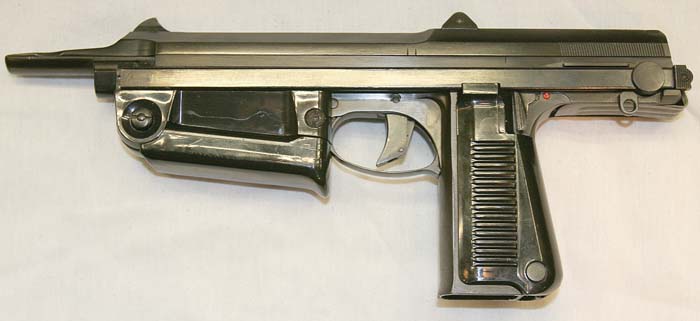By Lance Brown
Photos by Andy Kummerer
In response to a Polish government request in the late 1950s for a light, hand-held defensive weapon for use by rear echelon/support troops, design of the Wz 63 was initiated by Piotr Wilniewczyc. Upon Wilniewczyc’s death in 1960, the design in 9x18mm Makarov caliber was finished by a team at the Lucznik Arms Factory located in Radom, Poland, in 1963. Production began in 1964, with the Polish Armed Forces and police adopting it for service in 1965. Also known as the PM-63 (pistolet maszynowy wz. 1963 or submachine gun model 1963) and the RAK (Reczny Automat Komandosa or hand-held automatic commando firearm), approximately 70,000 weapons were manufactured before production ceased in 1974.
Easily distinguished by its shovel shaped muzzle compensator, the Wz 63 is blowback operated and fires from an open bolt that is incorporated inside its slide. Capable of semi or fully automatic fire, the rate of fire is determined by the operator’s trigger manipulation. Rearward movement of the trigger to the first position results in semiautomatic fire; continued rearward movement results in fully automatic fire. In order to keep the fully automatic rate of fire to approximately 600-650 rounds per minute, the slide incorporates an inertia firing rate reducer that causes the slide to remain open for a fraction of a second during recoil when the slide is at its most rearward position.

The complete method of operation for fully automatic fire begins with the insertion of either a 15 or 25-round magazine into the magazine well located in the pistol grip. The operator then retracts the slide by either grasping the slide via the serrations on the rear of the slide and pulling the slide to the rear or by placing the end of the compensator against a hard surface and pushing the weapon forward. When the trigger is pulled fully to the rear, the slide moves forward and strips a cartridge from the magazine. When the cartridge becomes fully seated in the chamber, the extractor snaps over the cartridge rim and the slide’s fixed firing pin strikes the primer while the slide is still moving forward. Cartridge initiation causes the slide to stop forward movement and begin rearward movement against the recoil spring that is located under the stationary barrel. The empty casing is extracted from the chamber and travels with the slide until it reaches the ejector (which is a raised side of the magazine), where it is ejected through the ejection port located on the right side of the slide. The slide continues its rearward movement until the recoil spring is fully compressed and passes over a retarder lever, which snaps up to hold the slide to the rear. An inertia buffer in the rear of the slide continues rearward movement and compresses a buffer spring. When the buffer spring becomes fully compressed, it propels the buffer forward. The forward movement of the buffer pushes the retarder lever down, which allows the slide to move forward if the trigger is still fully depressed and cartridges remain in the magazine in order to repeat the firing cycle. Upon firing the last round in the magazine, the slide catch locks the slide open. To assist with accuracy when firing with both hands, the Wz 63 has a folding vertical grip made of plastic for the support hand and a retractable metal stock with a pivoting butt plate.

In the early 1970s, versions were made at the Radom factory in 9x19mm (designated the PM-70) and .380 ACP (designated the PM-73) calibers, but production soon stopped due to lack of demand. An unlicensed version, designated the Type 82, was produced by the People’s Republic of China in 9x18mm Makarov caliber.
While the author was examining the Wz 63, the curator related an amusing tale. A Polish visitor became very animated when shown the Wz 63 that included a lot of hand waving and loud speaking. It seems the visitor, a veteran of the Polish Armed Forces, did not heed Lt. Colonel Jeff Cooper’s firearms safety rule number two, “Don’t point the muzzle at anything you are not willing to destroy.” While operating the Wz 63, the Polish veteran used the forefinger of his support hand to push back on the muzzle compensator to cock the weapon. For whatever reason, he failed to remove his forefinger from in front of the muzzle before pulling the trigger. The animated hand gestures of the visitor were an attempt to bring attention to his missing finger tip!
Wz 63 Specifications
Caliber: 9x 18mm Makarov
9x 19 Parabellum (PM-70)
.380 ACP (PM-73)
Operation: Straight blowback, slide with integral breech bolt firing
from open bolt, automatic, selective fire trigger system
with slide-mounted thumb safety. Short pulls of the
trigger result in semiautomatic fire; full pulls result in
automatic fire.
Weight, empty: Approximately 56 ounces (1.6 kg).
Length, overall,
stock stored: 13.1 inches (333 mm).
Length, overall,
stock extended: 23 inches (583 mm).
Height (15-round magazine inserted): 5.7 inches (145 mm).
Height (25-round magazine inserted): 8.4 inches (213 mm).
Barrel: Chrome lined with either four or six grooves with a
right-hand twist of one turn in 10 inches.
Barrel length: 6.0 inches (152 mm).
Magazine: 15 or 25-round, double column, detachable box-type.
Sights: Flip, fixed rear (settings for 492 feet (150 meters)
and 246 feet (75 meters) and front blade.
Sight radius: 6.0 inches (152 mm).
Grip panels: Black plastic.
Status: No longer in production, but still in service with
Poland. An unlicensed copy known as the Type 82 is
still in service with the People’s Republic of China,
Cuba and Vietnam.
Manufacturer: Lucznik Arms Factory, Radom, Poland; Type 82,
Norinco, China.

| This article first appeared in Small Arms Review V12N11 (August 2009) |











